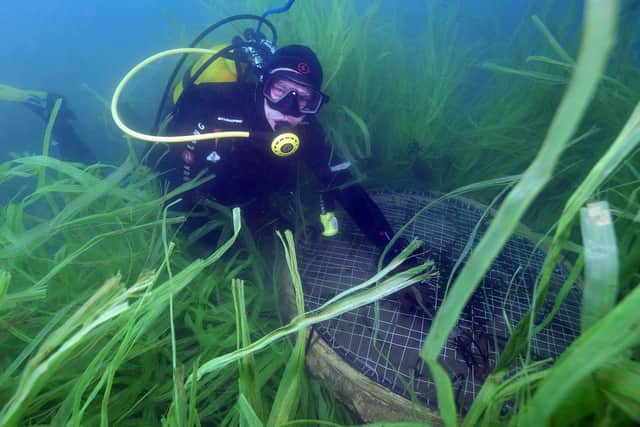Climate change: Why restoring Scotland's seagrass beds is vital for nature and the fight against global warming – Douglas Chapman MP
However, the publication of the Intergovernmental Panel on Climate Change’s latest report should put that argument firmly back in its box – we are still on “code red” for humanity and the transition to renewables and efforts to restore nature must not be paused if we are to maintain the target of no more than 1.5 degrees Celsius of warming.
Anything above this temperature will produce catastrophic and irreversible changes with the “window of opportunity to secure a liveable and sustainable future for all” firmly shut in our faces.
Advertisement
Hide AdAdvertisement
Hide AdWith this kind of unequivocal warning in place, there should be no prevarication on the epic scale of our response.
Inger Andersen, the United Nations’ Under-Secretary General and executive director of the UN Environment Programme, argues that we must “let nature do the job it spent millions of years perfecting” with “large scale ecosystem restoration from ocean to mountaintop” in order to adapt to and slow climate change.
The UN has christened the 2020s the “Decade on Ecosystem Restoration” in order to focus hearts and minds on the urgent task ahead.
The IPCC report urges action to protect 30 to 50 per cent of the world’s land and seas to maintain and enhance “the resilience of the biosphere”.


It seems apt then, in World Seagrass Month, to focus on the huge benefits of the restoration and preservation of seagrass beds as “lungs of the sea” and the enormous potential they possess as rich ‘blue carbon’ stores, biodiverse habitats, water purifiers and as a bulwark to coastal erosion.
At present, seagrasses, as marine powerhouses, are under threat, with two football pitch-sized areas destroyed every hour across the world, according to the UN. These beautiful underwater meadows are in danger due to human activity, climate change, invasive non-native species and disease – the same unholy trinity of cause and effect we see replicated across our natural world.
According to NatureScot, seagrass may be responsible for about 15 per cent of carbon storage on the seafloor, sequestering carbon far faster than many terrestrial habitats.
Unfortunately, the UK coastline has lost up to 92 per cent of these underwater meadows due to pollution, damaging fishing practices and coastal development, with seagrass beds declining by 58 per cent in Scotland since the 1930s.
Advertisement
Hide AdAdvertisement
Hide AdNow, in the 21st century, given that Scotland currently holds 20 per cent of the seagrass beds in north-west Europe, we are in a privileged position to both protect and restore this large area of marine habitation, and combat climate and global anxiety with action and nature-based solutions.
I have written in the past on the dual nature of this unique opportunity and responsibility as a turning point in our history – with so much of Europe’s natural resources, Scotland must act as guardians of this abundant potential to build a greener, fairer and more sustainable future with nature at the very core of this mission.
Of course, there are some incredible community-based projects in Scotland which are way ahead of the game in this respect, including a new project in my own constituency called Restoration Forth, a community-led initiative to restore seagrass meadows and oyster populations in the Firth of Forth.
Restoration Forth is supported by the ScottishPower Foundation and is to be managed by the WWF in partnerships with scientists, charities and local community groups. It has an amazing cluster of partners involved including Heriot Watt University, Project Seagrass, the Royal Botanic Garden in Edinburgh and the Ecology Centre at Kinghorn in Fife.
I was delighted to visit the Ecology Centre this year to hear more about this project and their important focus on community engagement as key to its long-term success, with local groups re-connecting with their natural environment, rich cultural and historical ties to the sea, and the climate and social benefits of restoration.
In Argyll, another project which deserves an honourable mention is Seawilding at Loch Craignish, a community-led marine habitat restoration charity doing incredible work to develop best-practice, low-cost methodologies and a how-to practical guide to help other coastal communities to do the same.
In 2021, they planted a quarter of a hectare of seagrass and in 2022 they plan a further half hectare alongside native oyster restoration. And it is community volunteers who are at the heart of the positive progress of this project.
Just before Christmas, Scotland’s first seagrass restoration guide was published, developed by NatureScot in collaboration with Marine Scotland and Project Seagrass, an environmental charity devoted to the conservation of seagrass ecosystems through research, community and action.
Advertisement
Hide AdAdvertisement
Hide AdThis guide is a direct response to interest in this area, to advise on all aspects of seagrass restoration, such as site suitability, licensing, biosecurity, techniques and monitoring.
In the face of this all-encompassing climate emergency, the stark warnings for our future and a world now battling the challenges of war as well as the pandemic, communities are coming together to lead the way on seagrass restoration as a bulwark against biodiversity loss and an enormous carbon sequestration resource.
Communities are acting despite some commentators’ attempts to stall on the radical changes needed to save our planet. In Scotland, we must support and nurture this local empowerment and engagement – in order to protect all our futures.
Douglas Chapman is the SNP MP for Dunfermline and West Fife
A message from the Editor:
Thank you for reading this article. We're more reliant on your support than ever as the shift in consumer habits brought about by coronavirus impacts our advertisers.
If you haven't already, please consider supporting our trusted, fact-checked journalism by taking out a digital subscription.
Comments
Want to join the conversation? Please or to comment on this article.
